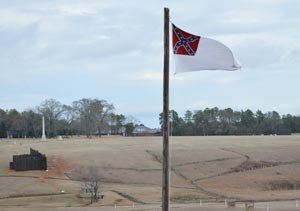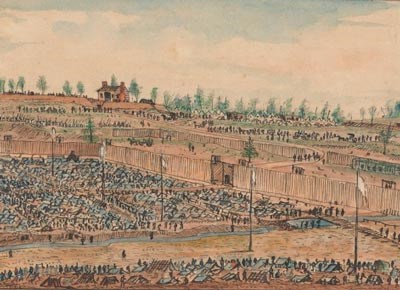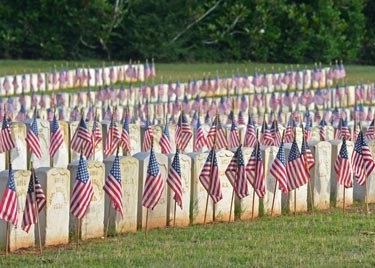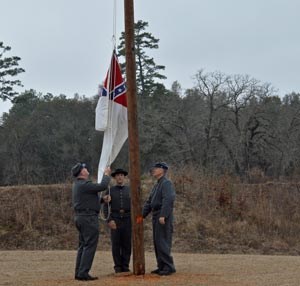|
What is a flag but the representative of an idea or principle or cause? In itself it has no meaning, but when used to represent a principle or a just cause men will face certain death in its defense. - Norton Parker Chipman, 1910 
NPS/C. Barr 
Robert Knox Sneden Diary (Mss5.1Sn237.1) Virginia Historical Society, Richmond, VA It is difficult to identify specifically which Confederate flag flew over the site. Some prisoners' illustrations depict the rectangular flag of the Army of Tennessee flying over the headquarters. Others show the Second National Flag. A few show regimental battle flags and colors around the guard camps. It is possible that each of these flags flew over the site at various times during the fourteen months Andersonville was open. Flags we know for certain that flew over the prison site were a series of white flags inside the stockade. Prisoner A.G. Blair, 122nd New York Infantry, recalled that, "Captain Wirz planted a range of flags inside the stockade, and gave the order, just inside the gate, "that if a crowd of two hundred…should gather in any one spot beyond those flags and near the gate, he would fire grape and canister into them." These white flags provided the guards with easy targets in the event that they needed to quickly cover the prison site with cannon fire. Prisoners at Andersonville at times shared their thoughts about the flag flying over them in captivity both at Andersonville and elsewhere. Robert H. Kellogg, 16th Connecticut Infantry, referred to the Confederate flag at Andersonville as an "ill-omened emblem" and described prisoners singing a song,
Prisoner Warren Lee Goss described weeping for the south because "folks were such fools as to live under a flag with three stripes [referring to the Confederate First National Flag], when they might have one with thirteen over them." Confederate soldiers stationed here likely saw the flag at the prison with a great sense of pride. For many of the reservists serving as guards, many of whom had lost brothers, fathers, and sons to the war already, the opportunity to serve under a Confederate flag gave them a sense of belonging and purpose in the cause for southern independence. They too were serving their country. 
Connecticut Historical Society Although a Confederate flag flew over the prison stockade, the American Flag was present inside, both in spirit and in body. Although it was considered contraband that could be confiscated and destroyed upon discovery, even a glimpse of the Stars & Stripes could give prisoners hope. When the 16th Connecticut Infantry was captured, the men cut up their regimental flag to prevent its capture, and each of the men carried a fragment of the flag into captivity as a reminder of what they fought for. On the Fourth of July, a group of prisoners waved a small American Flag, prompting a rousing cheer from their fellow captives. The Confederate staff searched for the men with this flag in order to confiscate it and punish them, but proved unsuccessful. 
Harper's Weekly Flags symbolized not only suffering in captivity, but freedom from it as well. Many prisoners described in memoirs the elation felt the first time they saw the American Flag. Goss wept, "Thank God for his mercy, [we] were again under the old flag. How our tear-dimmed eyes gazed at its folds, and we, with solemn, sobering voices, said 'Thank God! Thank God!'" Men held in captivity under one flag have a special appreciation for the power of the American Flag. In May 1865 Camp Sumter Military Prison at Andersonville ceased to exist, and the flags at the site disappeared. Before the end of the summer, a familiar flag once again proudly waved at Andersonville. On August 17, Clara Barton was given the honor of raising the American Flag in a ceremony establishing the national cemetery.

NPS/C. Barr Although a Confederate flag stood over 45,000 prisoners for fourteen months in 1864 and 1865, the Stars & Stripes has since proudly waved in honor of the sacrifices made both by those held here and those buried in the national cemetery. For nearly 150 years, those buried here are honored each Memorial Day with the placement of today more than 20,000 American flags at each grave. To mark the 150th anniversary of Andersonville, from February 2014 until May 2015, a Second National Flag of the Confederacy will be flown over the Star Fort, site of the Confederate headquarters. The Second National Flag was selected for this because it was the official banner of the Confederate government through most of the prison's operation. This allows the park to best recognize the broad meanings that flags held at Andersonville for Confederate officials, guards, prisoners, civilians, and slaves. 
NPS/C. Barr The decision to fly a Confederate flag at the site is not taken lightly. For many, it is a symbol of personal and regional heritage & pride, especially for many southerners who can trace ancestors in the Confederate Armies and even the guard force here. Others see it as a disrespectful banner of slavery, racism, and violence. Our purpose is neither to wave this flag as a symbol of southern pride nor as a disrespectful affront to those who suffered under it and against it. The Second National Confederate Flag flies at the Star Fort in order to both recognize the role of the Confederate army at the site and to consider the broader scope of the conflict. The flag serves as a tool with which to engage visitors in conversations about loyalty, captivity, freedom, and responsibility. |
Last updated: June 20, 2017
